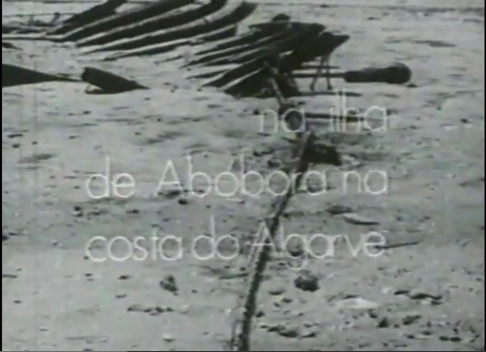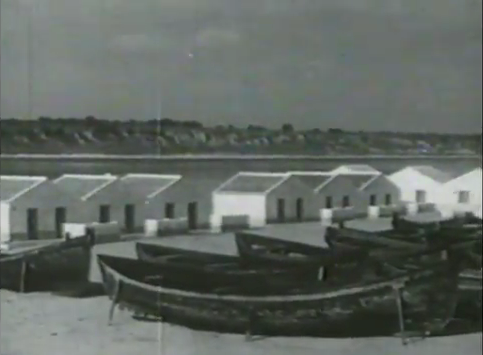para saltar para a descrição portuguesa, portuguese, por favor clique aqui.
Once upon a time…

… when the Algarve was not the turistical zone like it is today, what supported the life of many men and their families living on the coast were a fish called tuna, those were the times when “Ilha de Cabanas” was called "Ilha da Abobora".
Although the tuna is not an exotic fish, everyone surely must have heard of it, specially of the cans made with its flesh.
Being the tuna a highly nutritious fish, there was not one body portion which were not used, it is fished from the most remote antiquity, employing sophisticated techniques, although hand-made, it was needed the entire workforce and time of hundreds of people to build the nets, and move them to the sea, which explains the origin of “armações” – fishermen harbors - , which were almost like real villages, of which the “Armação da Abóbora” (Abóbora is the portuguese word for pumpkin) were an example, Of those fishing techniques there was a special structure called Almadrava that stretched for several hundred meters, and was composed of iron and fixed to the seabed through several anchors.
The ‘Armação da Abóbora”, were , like many other ‘Armação’ like Armação do Barril (the houses near the Barril beach), located on the west side of Tavira Island and the ‘Arraial Ferreira Neto’ (now an hotel), harbored a doctor, school, policemen, and even, in the case of the Arraial, a church.
Those "villages" never arrived, however, to be of permanent residence, since the fishermen were only there for a period of six months (from March to October, between the migratory waves of tuna - the so-called "direito" (from the Atlantic to the Mediterrean) and "revés" (on the opposite direction). The current village of Cabanas began to be called precisely "Cabanas da Armação", due to its proximity of the “Armação da Abóbora”.
In these times, the Ria Formosa was longer and deeper than at nowadays, and the island stretched far into the sea, being more like the islands of Armona and Tavira are now. This change in the geomorphology of the island is a natural process, however, in the case of Abobora Island, consisted in a series of man-made interventions that had the bad outcome which sealed with the tragic fate that led to the destruction and complete disappearance of all the houses of the Armação da Abóbora by the sea.
Remains as a living memory of those times the movie entitled "The Almadrava Tuna" which immortalizes the golden age of tuna fishing, which documents the bustle that preceded the moving of the Almadrava to the sea. " The film is available on YouTube, just follow the link: https://www.youtube.com/watch?v=PRN-V6ZZEB0.
The cache
This is a microcache, made from an old pepper spice jar, containing just the logbook. It does not have any writing materials in it.
It's hidden on the promenade, so we advise you to be extra careful in order to avoid being detected, specially in the summer peak months like July or August. We recommend going early in the morning, between the 8:30 and 10:00 am, as the first boats that do the ria's crossing start to sail at 8:15 am . We advise against doing it late in the evening, because at that moment there's many people returning from the beach anxious to return home, that form long queues above the promenade.
Unfortunately, the island is only accessible via the transport provided by fishermen boats, with regular crossings between the months of April and October.
--
Era uma vez…
Noutros tempos, em que o Algarve não era o paraíso demandado pelos veraneantes nos meses de Verão, o que dava dinheiro às famílias da região era um peixe chamado atum. Apesar de não ser um peixe exótico, e toda a gente com certeza já deve ter ouvido falar nele, nem que seja pelas conservas. Este peixe, extremamente nutritivo, não havendo nenhuma parte do seu corpo que não seja aproveitada, é pescado desde a mais remota antiguidade, empregando técnicas de pesca sofisticadas, apesar de artesanais, chegavam a mobilizar centenas de pessoas, obrigando-as a dedicar a tempo inteiro todas as suas energias na captura do animal, o que explica a origem das “Armações” da pesca do atum, verdadeiras aldeias, da qual a Armação da Abóbora foi um claro exemplo, e que eram habitadas sazonalmente por todos os intervenientes na campanha, fazendo-nos lembrar dos tempos em que a Ilha de Cabanas era conhecida por “Ilha da Abóbora”.
Tanta gente dedicava-se a manter e a lançar ao mar uma estrutura chamada Almadrava que estendia-se por várias centenas de metros, e que era constituída por ferros, sendo fixada ao fundo do mar por meio de inúmeras âncoras.
A “Armação da Abóbora”, que, como as demais “Armações” existentes, das quais apenas sobrevivem a Armação do Barril, na Ilha de Tavira, e o Arraial Ferreira Neto (actualmente um hotel), chegavam a contar com médico, escola, posto da guarda fiscal e mesmo, no caso do Arraial, uma igreja. Estas “aldeias” nunca chegavam, no entanto, a ser de residência permanente, uma vez que os pescadores apenas se encontravam lá durante um período de meio ano (de Março a Outubro, entre as vagas migratórias do Atum – os chamdos “atum de direito” - do Altântico para o Mediterrâneo - e “de revés” - na direcção oposta). A actual vila de Cabanas começou por se chamar precisamente “Cabanas da Armação”, devido à proximidade da Armação da Abóbora. Nesses tempos, aliás a Ria era mais longa e profunda do que actualmente, e a Ilha mais larga, sendo mais parecida como ainda as Ilhas de Tavira e da Armona são actualmente. Esta alteração da geomorfologia da ilha é um processo natural que, no entanto, no caso da Ilha da Abóbora, resultou de uma série de intervenções humanas erradas que tiveram como desfecho o trágico destino que culminou na destruição e desaparecimento total de todo o casario da Armação.
Permanece como memória viva desses tempos o filme de título “A Almadrava Atuneira” que imortaliza os tempos dourados da pesca do Atum e da azáfama que se vivia na preparação da Almadrava”. O filme está disponível no Youtube, siga o link: https://www.youtube.com/watch?v=PRN-V6ZZEB0.
A cache
A cache é micro, feita a partir de uma antigo frasco de especiarias. Contém apenas o logbook, não contendo qualquer material de escrita.
A Ilha de Cabanas é acessível infelizmente apenas através do transporte feito através de barco, com travessias regulares entre os meses de Abril e Outubro.
